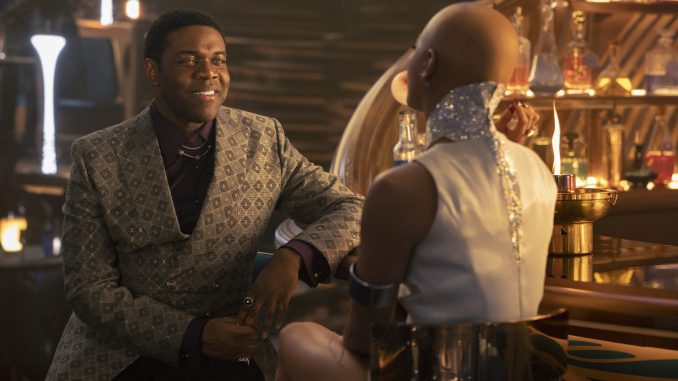
Olatune Osunsanmi’s new TV movie “Star Trek: Section 31” was originally intended to be a full-blown TV series and a proper spinoff to “Star Trek: Discovery.” The show was to follow Michelle Yeoh as the villainous Empress Philippa Georgiou, a bloodthirsty tyrant from another dimension, as she was recruited into a super-secret black-ops organization embedded deeply inside Starfleet. Although the Empress had murdered untold millions of people and regularly ate the flesh of her enemies, she was presented as somewhat sympathetic, having undergone a very mild personal redemption.
Starfleet understood Georgiou was morally bankrupt, but it required her brand of bankruptcy to commit acts of covert terrorism to keep the Federation’s utopia maintained. Plans for a “Section 31” TV series stretch back as far as at least 2019. By 2023, however, the “Star Trek” franchise had entered a state of widespread contraction, with most of the property’s then-ongoing shows being canceled one after the other. Also, Yeoh won an Academy Award for “Everything Everywhere All at Once,” so her ability to commit to a TV series became nebulous. As a result, “Section 31” was refashioned as a standalone streaming TV movie event (the first in “Star Trek” history).
“Star Trek: Section 31” debuted on Paramount+ on January 24, 2025, and it is very much a January movie. It’s a lightweight, nondescript actioner full of broad, well-worn character types, not-so-funny humor, pretty generic fight scenes, and no meaningful connections to the “Star Trek” world at large. It was also met with mostly negative reviews and currently sports a mere 19% approval rating on Rotten Tomatoes (out of 42 reviews), which is the lowest RT rating in the history of the “Star Trek” franchise. /Film, in contrast, gave “Section 31” a semi-positive review, describing it (complimentarily) as B-movie trash. For the most part, however, the film was rejected by Trekkies and non-Trekkies alike.
Why didn’t “Section 31” catch on with audiences? Several reasons.
Section 31 couldn’t help but feel like the pilot to a TV series
The premise of “Section 31” is simple: Empress Georgiou has been hiding out outside the boundaries of Federation space, posing as a posh Fresh nightclub owner. Her nightclub, the Baraam, is a hive of scum and villainy, but it is far from wretched. It’s very high-end. The entire club can fold up and fly around the galaxy like a starship. She is then contacted by a character named Alok (Omari Hardwick) and subsequently re-enlisted back into Section 31 to track down a doomsday weapon of her own invention.
Aiding her quest are a sexy Deltan named Melle (Humberly González), a brash cyborg named Zeph (Robert Kazinsky), a Starfleet bureaucrat named Rachel Garrett (Kacey Rohl), a flippant shapeshifter named Quasi (Sam Richardson), and a hyper-intelligent microorganism piloting a humanoid suit that looks like actor Sven Ruygrok.
The ragtag group of “zany” characters undergo their dangerous mission without too many issues, finding that they work well together. Indeed, by the end of the film, Section 31 has more or less agreed that the above team should become permanent, with the Empress serving as their leader. The “angels” will now take their instructions from an off-screen “Charlie” (Jamie Lee Curtis) and sail around the cosmos in their spacebound nightclub righting wrongs. Or wronging rights, as the case may be.
Of course, since this is a TV movie and not a pilot episode, audiences will never see the further adventures of the Baraam, making “Section 31” feel presumptuous. Rather than feel like a complete adventure unto itself, “Section 31” comes across as a bunch of promises that will never be fulfilled. The characters aren’t fleshed out very well, presumably because they were meant to become more interesting in later episodes. The universe of the Baraam isn’t explored either because, again, that was originally meant to occur later on in a TV series that’s no longer happening.
With no additional episodes, “Section 31” feels incomplete.
Philippa Georgiou wasn’t a terribly deep character
In the early episodes of “Star Trek: Discovery,” audiences were introduced to a calm and noble character named Captain Georgiou (also Yeoh), who was swiftly killed in a conflagration with Klingons. When the U.S.S. Discovery accidentally shunted itself into the evil Mirror Universe on the show, its crew met a version of Georgiou who was alive, yes, but also a violent cannibal tyrant. The crew of the Discovery thusly kidnapped her and brought her to the “good” universe, where she found she wasn’t allowed to murder with quite the same impunity. Empress Georgiou, as the character was known, remained a semi-regular part of “Discovery” through the show’s third season before eventually exiting the series by walking through a time portal.
While Yeoh is having fun playing such a cartoonishly evil character, Empress Georgiou has yet to exist beyond the realm of “fun villain.” She’s not deep or complex, having been raised evil in an evil universe. Additionally, the writers of “Discovery” and “Section 31” never took full advantage of what Empress Georgiou brought to “Star Trek.” How would the ordinarily diplomatic, intelligent, and nonviolent members of Starfleet react to someone who was raised to be wicked in a malevolent universe? What sort of discussions would they have? How would they argue about or debate each other’s morality?
Instead, Empress Georgiou proved to be a little like Emperor Palpatine from the “Star Wars” franchise in that just loves being evil, and that’s it. And while that type of character can certainly be fun as an antagonist, she’s also the last kind of character one might want to lead a TV series, especially a caper that blends elements of the spy, comedy, and action genres with an ensemble of differing character types. Imagine “Ocean’s Eleven,” but one member of the team is Cannibal Space Hitler. She had nowhere to go, no leadership skills, and would never change. Michelle Yeoh is an amazing lead actor, but Georgiou was never meant to be a lead character.
The other characters in Section 31 also kind of sucked
When compiled in a pitch packet, the main characters of “Section 31” seem interesting enough. Alok is the “mysterious man with a past,” while Quasi is the humorous character overwhelmed by the violence around him. Elsewhere, Rachel Garrett is the straight-laced pencil-pusher, whereas Zeph is the low-intelligence muscle. Melle offered some potential sexual chaos, and I like the idea of a microorganism piloting a human-sized robot suit. And, of course, there was Cannibal Space Hitler herself, Empress Georgiou. If these characters were given sharp writing and interesting, complex personalities, there’s no reason they shouldn’t be wholly appealing.
But they weren’t, and they weren’t. The characters may have had potential, but they didn’t live up to it. Their senses of humor were unfunny and clunky. There’s an extended bit wherein one character is confused as to whether a doomsday device is called “Godsend” or “God’s End,” and it doesn’t bring any humor to the scene, nor does it serve as any kind of character moment. No one reveals a tragic (or whimsical) backstory that would make them seem richer or more nuanced, and everyone lacks heart. The filmmakers seemed to be shooting for a vibe akin to James Gunn’s 2014 movie “Guardians of the Galaxy.” That film was also a pretty standard thriller with a “we must retrieve the doomsday device from a generic villain” story, but Gunn gave his characters actual humor and, dare I say, heart. “Guardians of the Galaxy” has a huge number of fans.
“Section 31” has no heart, unfortunately, and its characters never emerge beyond their vague casting-sheet descriptions. They don’t develop unique relationships, don’t bond, don’t engage in playful banter, and never become more humane. Without that sparkle, a sci-fi action thriller isn’t going to work.
Section 31’s action wasn’t very good
It has previously been stated in the pages of /Film that “Star Trek” functions best when it’s eschewing violence and action. The “Star Trek” franchise is, in terms of genre, very pliable, of course, having encompassed Westerns, murder mysteries, morality plays, musicals, and animated crossovers. Be that as it may, the franchise’s overarching utopian sense of pacifism has always been its strongest binding element. When the makers of “Star Trek” fall into the “use violence to solve problems” tropes of action movies, it starts to lose sight of its thesis.
But “Section 31” was determined to be an action thriller, so audiences had to contend with its fights, explosions, and phaser battles. It also stands to reason that if one is going to hire Michelle Yeoh for an action thriller, one might as well take advantage of the superstar’s well-documented martial arts skills. So, genre complaints aside, how is the action in “Section 31?”
As it so happens, it is wholly unimpressive. There is nothing clever, unique, or witty about the action sequences. There is a fight early in the film wherein Georgiou and a masked assailant both activate high-tech personal phasing devices, allowing them to pass through walls while still being able to punch one another. One might think this would provide a few moments of visual wit or a fight sequence wherein the fighters become tangible and intangible in turn. No such luck. The fight is just a fight, only with a “shimmer” visual effect laid over the actors.
Later in the film, characters ride on top of a high-speed vehicle and it very much looks like actors performing against a green screen. It’s bad enough that “Section 31” leaned so hard into action movie tropes, but then it didn’t do anything interesting with the action itself. It’s all standard, dull fight nonsense.
Section 31 wasn’t really Star Trek at all
/Film previously commented that “Section 31” is as far from the core tenets of “Star Trek” that the franchise has ever strayed. For the most part, “Star Trek” is set among characters who work for Starfleet, the benevolent military force devoted to exploration, cultural exchange, and philosophical betterment. When “Star Trek” steps out of that world, it often flounders, unable to define what a galaxy-wide utopia looks like among civilians.
“Section 31” declares that the utopia of “Star Trek” isn’t possible without teams of violent misfits operating in the shadows and committing murder as a matter of course. If shadowy murders are required to keep your utopia afloat, then guess what? You’re not living in a utopia. One might even call it a dystopia. You can live in peace and harmony, but it must be built on the bones of “enemies.” Not cool, dude.
Additionally, “Section 31” isn’t set on a Starship, so its sole Starfleet character barely has anything to contribute. There are references to the larger “Star Trek” universe, while alien species are borrowed from previous “Star Trek” shows and movies, yet the film makes no deeper reference to any extant “Star Trek” lore. Indeed, one could have changed the screenplay’s proper nouns and released “Section 31” as a non-“Star Trek” project, and it would have functioned identically. “Section 31” looks like the corny 1990s Sci-Fi Channel TV movies that Trekkies once had to wait through before a block of “Star Trek” reruns began.
As such, “Section 31” is a movie for nobody. It doesn’t have good action, its storytelling is bland, its characters are broad, and its setting is generic. It wasn’t a film that was going to attract either old-school Trekkies or general action movie buffs. At the end of the day, “Section 31” failed because it just wasn’t very good.
“Star Trek: Section 31” is streaming on Paramount+.

Leave a Reply